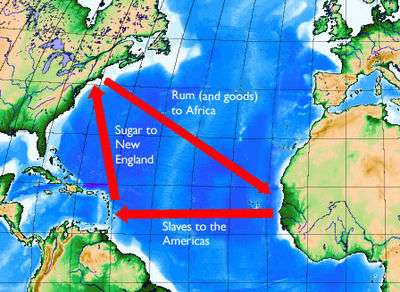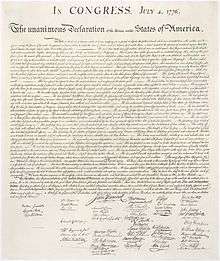William Whipple
| William Whipple | |
|---|---|
 Portrait by Walter Gilman Page | |
| Born |
January 14, 1730 Kittery, Maine |
| Died |
November 28, 1785 (aged 55) New Hampshire |
| Allegiance |
|
| Service/branch |
|
| Rank |
|
| Commands held | New Hampshire Militia (Bellow's Regiment of Militia, Chase's Regiment of Militia, Moore's Regiment of Militia, Welch's Regiment of Militia) |
| Battles/wars | American Revolution, Battle of Saratoga, Bemis Heights, Battle of Bennington, Battle of Rhode Island |
| Spouse(s) | Catherine Moffat Whipple |
| Signature |
|
William Whipple, Jr. (January 25, 1731 NS (January 14, 1730 OS – November 28, 1785) was a signatory of the United States Declaration of Independence as a representative of New Hampshire. Whipple was a member of the Continental congress from 1776 through 1779.[1] Before becoming a politician, Whipple worked as both a ship's captain and a merchant. He studied in college to become a judge. Whipple died of heart complications in 1785, aged 55.[1]
Personal life
Whipple was born in Kittery in southern Maine, to Captain William Whipple Sr. and his wife Mary (née Cutt),[2] and educated at a common school studying how to be a merchant, judge, and a soldier until he went off to sea. He became a Ship's Master at the age of 21.[3][4] He married his first cousin Catherine Moffat in 1767.[3] Whipple and his wife moved into the now historic Moffatt-Ladd House on Market Street in Portsmouth in 1769.[5][3] They had a son, William Whipple III, who died in infancy.[4]
Masonic Affiliation
Whipple was an active member of the Freemasons. Whipple was a member of the St. John's Masonic Lodge while he was an active mason. He was one of nine signatories of the Declaration of Independence who were masons.[6][7]

Time as a Sailor and Merchant
Whipple earned his fortune participating in the Triangle trade of the West Indies and Africa.[3] Whipple became an established and affluent captain, with cargo such as wood, rum, and on at least one occasion, slaves.[8][9] His trading activities may have been primarily confined to the West Indies.[3] In 1759 he landed in Portsmouth, New Hampshire, and in partnership with his brother established himself as a merchant.
Political career
Whipple, a trusted and well respected member of society, was elected to the New Hampshire Provincial Congress before being selected as a representative of New Hampshire in the Continental Congress. There, Whipple was a signatory of the Declaration of Independence. Whipple was appointed New Hampshire tax collector in 1782 by the Superintendent of Finance Robert Morris.
Provincial Congress
In 1776, New Hampshire dissolved the British Royal government and organized a House of Representatives and an Executive Council known collectively as a Provincial Congress. In 1775, Whipple was elected to represent his Portsmouth, New Hampshire at the Provincial Congress that met in Exeter, New Hampshire.[10] In 1776 New Hampshire dissolved the Royal government and reorganized with a House of Representatives and an Executive Council. Whipple became a Council member, and a member of the Committee of Safety.
Continental Congress
Whipple was elected to the Continental Congress, serving through 1779. Whipple signed the Declaration of Independence while representing New Hampshire at the Continental Congress. Whipple was also the second cousin of fellow signatory, Stephen Hopkins.[2] Whipple took his patriotic duty seriously, and was known around New Hampshire for his dependability and righteousness. In January 1776, Whipple wrote to fellow signatory Josiah Bartlett of the approaching convention: “This year, my Friend, is big with mighty events. Nothing less than the fate of America depends on the virtue of her sons, and if they do not have virtue enough to support the most Glorious Cause ever human beings were engaged in, they don’t deserve the blessings of freedom.”[3] After returning from the signing of the Declaration of Independence, Whipple planted the seed of a horse chestnut next to his house, which has grown into a tree which can still be seen today next to the Moffat-Ladd house.[4]

Views of Equality
Whipple was known for his beliefs that all men were created equal, and is quoted as writing "A recommendation is gone thither for raising some regiments of Blacks. This, I suppose will lay a foundation for the emancipation of those wretches in that country. I hope it will be the means of dispensing the blessings of Freedom to all the human race in America.".[4]

Military Career
Whipple was given his first commission by the New Hampshire Provincial Congress in 1777. At Saratoga, Whipple was placed in command of a brigade, consisting of four regiments of militia. Whipple commanded Bellow's regiment, Chase's regiment, Moore's regiment, and Welch's regiment. As a result of their meritorious conduct at the Battle of Saratoga, Whipple and Colonel James Wilkinson were then chosen by Major General Horatio Gates to determine terms of capitulation with two representatives of General John Burgoyne. Whipple then signed the Convention of Saratoga, the effective surrender of General Burgoyne and his troops.[11] Whipple was then appointed along with several other officers to escort Burgoyne and his army back to Winter Hill, Somerville, Massachusetts. Whipple passed the news of the victory at Saratoga to Captain John Paul Jones, who informed Benjamin Franklin, who was in Paris at the time. New of the victory proved valuable to Franklin throughout alliance negotiations with the French. In 1778, Whipple followed his commanding officer, General John Sullivan to the Battle of Rhode Island, where he commanded Evans' regiment, Peabody's regiment, and Langdon's light horse regiment. After General Sullivan ordered retreat, Whipple and other officers resided in a house near the battlefield. The approaching enemy fired a field piece from a range of three-quarters of a mile. The shot first tore through a horse lashed outside the house before severely wounding the leg of one of Whipple's brigade majors, which later required amputation.[12]
After the Revolution
After the war Whipple became an Associate Justice of the Superior Court of New Hampshire. He suffered from a heart ailment, and died after fainting from atop his horse while traveling his court circuit. He was buried in the Old North Burial Ground in Portsmouth, New Hampshire. In 1976, in conjunction with the American Bicentennial, his headstone was replaced with a new memorial by a local historical association.
Surrender of General Burgoyne
Painted by John Trumbull in 1821, The Surrender of General Burgoyne is an oil painting depicting many of the major officers in the Saratoga Campaign.[13] Brigadier general Whipple is depicted fifth from the right, standing beside fellow brigadier general, John Glover.
References
- State Builders: An Illustrated Historical and Biographical Record of the State of New Hampshire. State Builders Publishing Manchester, NH 1903
- Lives of the Signers to the Declaration of Independence. By Rev. Charles A. goodrich, published by William Reed & Co. New York 1829
- 1 2 "Signers of the Declaration of Independence: William Whipple".
- 1 2 "General Whipple's Ancestors".
- 1 2 3 4 5 6 DSDI staff (11 December 2011). "William Whipple". The Society of the Descendants of the Signers of the Declaration of Independence.
- 1 2 3 4 Vaughan, Dorothy Mansfield. "This Was a Man".
- 1 2 "The Whipples". Moffatt-Ladd House & Garden.
- ↑ "Famous Masons".
- ↑ "First President, First Mason".
- ↑ "Framers of Freedom: William Whipple".
- ↑ "William Whipple and the Declaration of Independence".
- ↑ http://www.cr.nps.gov/history/online_books/declaration/bio51.html[]
- ↑ http://www.nps.gov/parkhistory/online_books/declaration/bio51.html[]
- ↑ Kieffer, Mike. "Founding Father Document - Biography for William Whipple".
- ↑ "Surrender of General Burgoyne".
External links
- Biography by Rev. Charles A. Goodrich, 1856
- Burial site of William Whipple
- Genealogical Reference
- William Whipple at Find a Grave
- Colonial Hall
- William Whipple and the Declaration of Independence.

